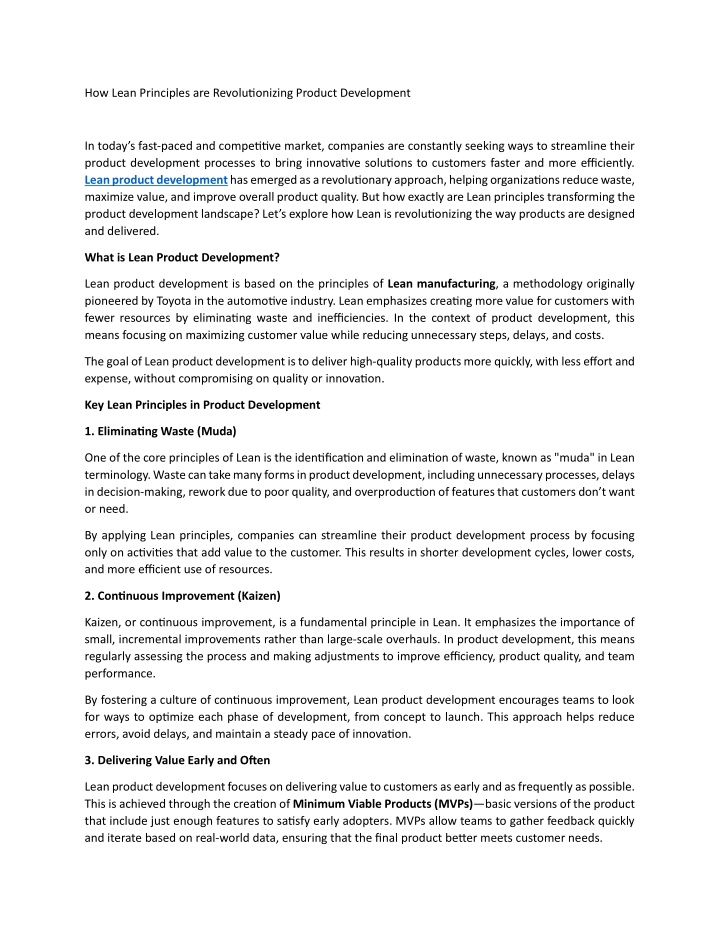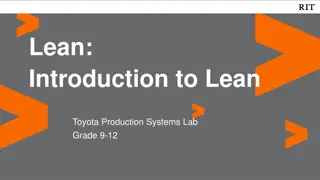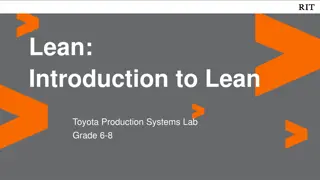
How Lean Principles are Revolutionizing Product Development
Lean product development is based on the principles of Lean manufacturing, a methodology originally pioneered by Toyota in the automotive industry.
Download Presentation

Please find below an Image/Link to download the presentation.
The content on the website is provided AS IS for your information and personal use only. It may not be sold, licensed, or shared on other websites without obtaining consent from the author. If you encounter any issues during the download, it is possible that the publisher has removed the file from their server.
You are allowed to download the files provided on this website for personal or commercial use, subject to the condition that they are used lawfully. All files are the property of their respective owners.
The content on the website is provided AS IS for your information and personal use only. It may not be sold, licensed, or shared on other websites without obtaining consent from the author.
E N D
Presentation Transcript
How Lean Principles are Revolutionizing Product Development In today s fast-paced and competitive market, companies are constantly seeking ways to streamline their product development processes to bring innovative solutions to customers faster and more efficiently. Lean product development has emerged as a revolutionary approach, helping organizations reduce waste, maximize value, and improve overall product quality. But how exactly are Lean principles transforming the product development landscape? Let s explore how Lean is revolutionizing the way products are designed and delivered. What is Lean Product Development? Lean product development is based on the principles of Lean manufacturing, a methodology originally pioneered by Toyota in the automotive industry. Lean emphasizes creating more value for customers with fewer resources by eliminating waste and inefficiencies. In the context of product development, this means focusing on maximizing customer value while reducing unnecessary steps, delays, and costs. The goal of Lean product development is to deliver high-quality products more quickly, with less effort and expense, without compromising on quality or innovation. Key Lean Principles in Product Development 1. Eliminating Waste (Muda) One of the core principles of Lean is the identification and elimination of waste, known as "muda" in Lean terminology. Waste can take many forms in product development, including unnecessary processes, delays in decision-making, rework due to poor quality, and overproduction of features that customers don t want or need. By applying Lean principles, companies can streamline their product development process by focusing only on activities that add value to the customer. This results in shorter development cycles, lower costs, and more efficient use of resources. 2. Continuous Improvement (Kaizen) Kaizen, or continuous improvement, is a fundamental principle in Lean. It emphasizes the importance of small, incremental improvements rather than large-scale overhauls. In product development, this means regularly assessing the process and making adjustments to improve efficiency, product quality, and team performance. By fostering a culture of continuous improvement, Lean product development encourages teams to look for ways to optimize each phase of development, from concept to launch. This approach helps reduce errors, avoid delays, and maintain a steady pace of innovation. 3. Delivering Value Early and Often Lean product development focuses on delivering value to customers as early and as frequently as possible. This is achieved through the creation of Minimum Viable Products (MVPs) basic versions of the product that include just enough features to satisfy early adopters. MVPs allow teams to gather feedback quickly and iterate based on real-world data, ensuring that the final product better meets customer needs.
By delivering value early, companies can test their assumptions, identify potential improvements, and ensure that the product is aligned with market demand. This approach significantly reduces the risk of investing time and resources into features that may not resonate with customers. 4. Building Cross-Functional Teams Lean product development encourages cross-functional collaboration. Instead of siloed departments working independently, Lean brings together engineers, designers, marketers, and other stakeholders to collaborate throughout the development process. This reduces communication barriers, ensures that everyone is aligned on project goals, and accelerates decision-making. Cross-functional teams are more agile and capable of responding quickly to changes in market conditions or customer feedback. This collaborative approach helps teams deliver higher-quality products faster, with fewer bottlenecks. 5. Just-in-Time Development The Just-in-Time (JIT) principle, borrowed from Lean manufacturing, applies to product development by ensuring that resources are used only when needed. This minimizes waste in the form of excess inventory, redundant features, or overproduction. JIT ensures that the right work is done at the right time, enabling teams to be more efficient and responsive. In product development, this could mean delivering features when they re most needed by customers or adjusting timelines based on real-time feedback rather than following a rigid project plan. How Lean Revolutionizes Product Development The implementation of Lean principles revolutionizes product development by fostering a more adaptive, customer-centric, and efficient process. Companies that embrace Lean benefit in several key ways: 1.Faster Time-to-Market: Lean's focus on eliminating waste and delivering value early enables teams to bring products to market faster. By shortening development cycles and focusing on high- priority tasks, Lean allows companies to respond quickly to market demands. 2.Improved Product Quality: Continuous improvement and early feedback loops ensure that products evolve based on customer needs. Lean product development encourages testing and validation at every stage, reducing the risk of costly errors or product failures. 3.Cost Reduction: By eliminating unnecessary steps, reducing rework, and using resources efficiently, Lean helps lower development costs. The focus on delivering only what adds value prevents over-investment in non-essential features. 4.Enhanced Innovation: Lean product development encourages experimentation and rapid iteration. Teams can quickly test new ideas, gather feedback, and make improvements, fostering a culture of innovation. Conclusion Lean principles are revolutionizing product development by transforming how teams approach efficiency, collaboration, and customer-centricity. By eliminating waste, focusing on continuous improvement, and delivering value early, Lean enables companies to build better products faster, with fewer resources. In an
era where speed and quality are critical to success, Lean product development is helping organizations stay competitive and drive innovation in a rapidly changing market. Read revolutionizing.html More: https://techhorizonsolutions.blogspot.com/2024/09/how-lean-principles-are-






















